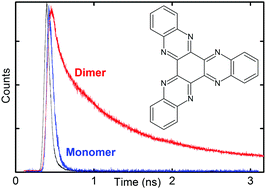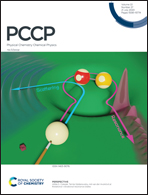Aggregation controlled photoluminescence of hexaazatri-naphthylene (HATN) – an experimental and theoretical study†
Abstract
Photophysics of hexaazatrinaphthylene (HATN) in solution and in the solid state is determined by the nπ* character of its lowest excited singlet state and by the ππ* character of the first triplet state. The relaxation of an electronically excited state is dominated by nonradiative relaxation channels and only very weak fluorescence is observed for HATN monomers in solution. In liquid solution, the fluorescence quantum yield is 3–7 × 10−4 and the triplet formation yield ranges from 0.21 to 0.41. In methanol, the photodegradation of the molecule is observed. This molecule with a large delocalised π-electron system easily aggregates forming dimers in solution and in some crystalline forms. The band shifts observed in crystals as well as excitonic splitting in dimers provide evidence for a strong interaction in π–π stacked aggregates. The mixing of electronic states in aggregates changes their character and affects photophysical properties. The obtained experimental data are in good agreement with theoretical calculations performed using the ADC(2) method.



 Please wait while we load your content...
Please wait while we load your content...